Friday, October 30, 2009
Wrap UP
Lets use an example of a 200 pound man who is 5 foot 8 inches tall, and is 40 years old. He is moderately active
66 + (6.23x200) + (12.7x68)-(6.8x40) = 1904 calories
1904 is the amount he burns at rest for 24 hours
Now multiply this time the conversion factor for moderately active (1.55)
1904x1.55 = 2951
So, our example man burns 2951 calories daily. Let's assume he is eating 1500 calories daily. The difference is 1451 calories daily. That means that over a 7 day period he will burn 10,157 calories more than he takes in. Divide this number by 3500(the number of calories in a pound - discussed in monday's post). The answer is 2.9. That is how many pounds he will lose in 7 days.
Its all in the math my friends. You should know what your numbers are.
Wednesday, October 28, 2009

1.2
Sedentary
Little or no exercise and desk job
1.375
Lightly Active
Light exercise or sports 1-3 days a week
1.55
Moderately Active
Moderate exercise or sports 3-5 days a week
1.725
Very Active
Hard exercise or sports 6-7 days a week
1.9
Extremely Active
Hard daily exercise or sports and physical job
Tuesday, October 27, 2009
Harris-Benedict Equation
 The young man pictured is using the equation to find out how to gain weight)
The young man pictured is using the equation to find out how to gain weight)This is the Harris-Benedict Equation. You plug in your weight, height, and age. The resulting number is your Basal Metabolic Rate. This is the number of calories you burn in a day if you never got off the couch (completely physically inactive). Tommorow, I will give you a conversion factor - a number to multiply by the result of this equation. This final answer will tell you the actual number of calories you burn daily - not just the number you burn if you are physically inactive.
Equation:
Women: BMR = 655 + ( 4.35 x weight in pounds ) + ( 4.7 x height in inches ) - ( 4.7 x age in years )
Men: BMR = 66 + ( 6.23 x weight in pounds ) + ( 12.7 x height in inches ) - ( 6.8 x age in year )
Monday, October 26, 2009
How Many Calories Do I Burn?

Wednesday, October 21, 2009
Serving Size Matters
Portion Size Increases
Tuesday, October 20, 2009
Heart Rate While Exercising

What should your heart rate be while exercising? The answer is that once warmed up you should be in a certain range. Take 220 and subract your age. We can use a 40 year old as an example. That would be 180. This is called "maximum heart rate." You should not go over this while exercising. Now take 2/3 of 180 and you have about 118. After warming up you should be above this figure but never higher than your max heart rate figure. This is the normal heart rate range while exercising. By staying in this range, you imporve heart and lung function and burn fat and calories.
Monday, October 19, 2009
Exercise DVD
Saturday, October 17, 2009
Final word on ideal plate
I typically grill the chicken, and cook the veggies in a small amount of olive oil. I like to add dry seasoning like "Mrs Dash". I usually cook brown rice in 99% fat free chicken broth and I always add mushrooms.
Wednesday, October 14, 2009
Dinner Continued - healthy starches

What about the quarter of the plate that is a healthy starch? Brown or wild rice is a good example. Sweet potatoes or red-skinned new potatoes are a good example. Notice that the serving size here is 1/2 cup on the wild rice. Trust me, your instinct is to eat 1 cup or more. You don't need that much. Eat to live, don't live to eat.
Need a good online calorie counter for free? Try one of these:
Monday, October 12, 2009
Dinner "Ideal Plate" Rule

Friday, October 9, 2009
Thursday, October 8, 2009
Encouragement
Wednesday, October 7, 2009
Biggest Loser Wrap Up
Tuesday, October 6, 2009
The Correct Lunch

Monday, October 5, 2009
Lunch




